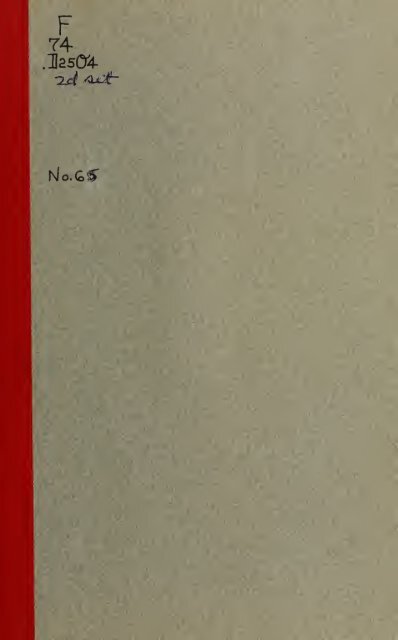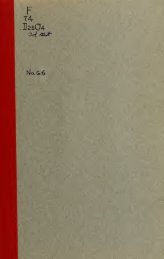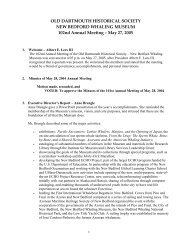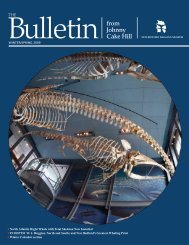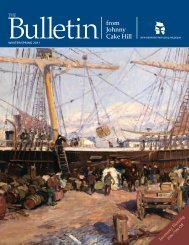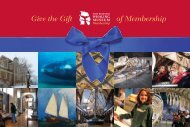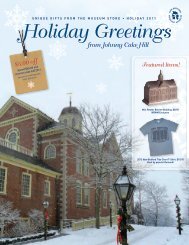Old Dartmouth historical sketches - New Bedford Whaling Museum
Old Dartmouth historical sketches - New Bedford Whaling Museum
Old Dartmouth historical sketches - New Bedford Whaling Museum
Create successful ePaper yourself
Turn your PDF publications into a flip-book with our unique Google optimized e-Paper software.
F<br />
74<br />
NIo.GS"
SAILS AND SAILMAKERS<br />
By JAMES FRANKLIN BRIGGS<br />
PAPER READ AT MEETING OF THE<br />
OLD DARTMOUTH HISTORICAL SOCIETY<br />
APRIL 27th, 1937<br />
THE tirr ;.r.Y of<br />
CONufleSS<br />
SEP J 1955<br />
50i,y___s4-<br />
OLD DARTMOUTH<br />
HISTORICAL SKETCHES<br />
No. 65<br />
In the Series of Sketches<br />
of <strong>New</strong> <strong>Bedford</strong>'s Early History
f 1^<br />
THE SAILMAKER<br />
— I'"niln llic ii.iinliim by ClilToril \V, Aslili'.v
SAILS AND SAILMAKERS<br />
•/^ITTLE has been recorded about the days and the ways of Sail-<br />
^1] makers. Yet sails brought Columbus to discover the <strong>New</strong> World<br />
^^ and the Pilgrims to found our commonwealth. When there were<br />
few highways, sails furnished the means of transportation and communication<br />
between the colonics. Again sails enabled our fathers to drag<br />
from the ocean the wealth that built our city. It is not unfitting,<br />
therefore, that our Society should have a passing interest in sails and<br />
sailmakers.<br />
It is suggested that the first physical force used by man beyond his<br />
own bodily powers was the force of the wind upon a crude sail. Whether<br />
this be so or not. we know that the origin of sails lies beyond the<br />
remotest horizon of history. We may imagine that some early savage.<br />
astride a floating log. found his loose garment of skin caught the wind<br />
and quickened the slow movement of the log.<br />
Perhaps he ceased poling<br />
along the bottom of a shallow lake, and raising the skin garment on<br />
the end of his pole, allowed the wind to take the place of muscular<br />
effort. ( 1 ) This may have been the first sail.<br />
Now leaving the field of prehistoric years that only the imagination<br />
can picture, let us explore a few early records. The Hebrew account<br />
of the building of the Ark gives the exact dimensions and the material<br />
of the Ark. but makes no allusion to sails. (2) Possibly sails were<br />
not known in those days, or more likely were not needed by Noah,<br />
since he had no place to sail<br />
to.<br />
Some early evidences of sails arc found in Egypt even on prcdynastic<br />
boats. Later sculptures depicting Egyptian boats at Punt on<br />
the Red Sea. in the reign of Queen Hatshepu about 14 50 B. C show<br />
that each boat carried many oars and one low mast with a<br />
wide rectangular<br />
sail spread between an upper and a lower yard. {\)<br />
In the fourth book of the Odyssey Menelaus says. "So soon as<br />
early Dawn shone forth, the rosy-fingered, first of all we drew down<br />
our ships to the fair salt sea. and placed the masts and the sails in the<br />
gallant ships, and the crew too climbed on board, and sat upon the<br />
benches, and smote the grey sea water with their oars." From this crystalclear<br />
picture we get several facts about boats of the twelfth century before
Christ. Tin- ships of these Greeks were drawn up on land. Such<br />
craft could have no depth of keel, and hence could not sail against the<br />
wind. The masts and sails were attached together and were taken<br />
down and put up as occasion demanded. Oars were used in the same<br />
boats with sails, doubtless when the wind gave out. or blew from an<br />
adverse direction.<br />
the sail<br />
In the twenty-seventh chapter of Ezckiel. verse seven describes<br />
of a Phoenician galley of the sixth century B. C. in these words:<br />
"Fine linen with broidcred work from Egypt was that which<br />
thou spreadest forth to be thy sail." This was written in disapproval<br />
of the lu.xury of the wealthy citizens of Tyre.<br />
The materials of which sails were made in the old world we-^c<br />
mainly hemp or flax, with coarse rattan matting used in the Far East,<br />
and tapa. a cloth made of bark, in the South Seas. In our country<br />
cotton duck is used almost exclusively. Lately light sails have been<br />
made of silk. In the 19 36 Boat Show in <strong>New</strong> York I saw a small boat<br />
rigged with a sail made of celophanc. The advantage of such a transparent<br />
sail is that when racing with another boat to leeward, you do<br />
not have to look under your boom to sec what your opponent is doing,<br />
because you can keep watch of him right through your sail.<br />
Apparently<br />
cclophane was not successful as sail cloth for no such sail appeared in the<br />
1937 Boat Show.<br />
We turn now from sails to sailmakcrs. The evidence of sails<br />
proves the existence of sailmakers as early as 3 500 years before Christ,<br />
but we have no record of who they were or how they worked.<br />
The Book of Acts tells us that the Apostle Paul was a tent maker.<br />
(4 I If the Jews had been a maritime people. Paul would doubtless<br />
have been a sailmaker. Indeed it is altogether probable that on his<br />
four Mediterranean voyages the skilled needle of Paul helped to mend<br />
rents in the ship's sails caused by the tempestuous Eurodydon.<br />
Let us pass over seventeen centuries and come from the distant<br />
Mediterranean to our own Buzzards Bay.<br />
Leonard Ellis in his "History<br />
of <strong>New</strong> <strong>Bedford</strong>" says that when Joseph Rotch came from Nantucket to<br />
our shores in 1765 "He found upon his arrival a little hamlet comprising<br />
among its inhabitants Joseph Russell. John Louden, shipbuilders:<br />
Benjamin Tabcr. block maker and boat builder: Gideon<br />
Mosher. mechanic: Elnathan Sampson, blacksmith." (5) If there<br />
was any sailmaker in the village at that time, he was not sufficiently<br />
important to be named.
now<br />
Under the vigorous leadership of Joseph Rotch. however, whaling<br />
and its allied crafts grew rapidly. "'From <strong>Dartmouth</strong> there were annually<br />
fitted (in the years) 1770-1775." says Leonard Ellis, "eighty<br />
vessels of 6,500 tonnage. Vessels were built on the<br />
Acushnet and Apponegansett Rivers, and sail lofts, rope walks, cooper<br />
shops and wharves came into existence." (6)<br />
If we bear in mind that all ships in those days moved only by means<br />
of sails, we will readily grant that as the shipping of <strong>New</strong> <strong>Bedford</strong> increased,<br />
the industry of sailmaking here must have grown proportionately<br />
in size and importance. In 1805 there were belonging to this<br />
port 112 vessels. By 185 3 there were more than three times as many.<br />
Five years later to outfit the whalers required 205.000 yards of canvas.<br />
(7) This indicates busy times for the sailmakers.<br />
We have said that when Joseph Rotch came from Nantucket he<br />
found here a certain shipwright named John Louden. This John<br />
Louden in I 760 purchased from that princely landowner Joseph Russell<br />
an acre of land on the water front south of Union Street. He constructed<br />
a wharf in line of the present Commercial Street. In 1787<br />
Louden sold what land he then had left to Isaac Howland. (8) who<br />
built a candle works and distillery at the head of the wharf. The whaif<br />
was subsequently called I. H G. Howland's. and later Commercial<br />
Wharf. (9)<br />
On this wharf in 1816 we find the following business houses:<br />
At number one. Charles R. Tucker. Ship Chandler and<br />
Grocer.<br />
At number three,<br />
the counting room of that famous shipping<br />
house. Isaac Howland. Jr. tJ Co.. whose members were<br />
then listed as Gideon Howland. Thomas Mandcll.<br />
Edward Mott Robinson and others.<br />
At the corner of Orange Street I<br />
were Chapman £J Bonney. Sailmakers.<br />
called Front Street)<br />
At number ten. Whitney t$ Lindsay, Grocers and Commission<br />
Merchants.<br />
And at an unnumbered location on I. ^ G. Howlands wharf<br />
was Simpson Hart. Sailmakcr.<br />
Who was this sailmaker Simpson Hart and where did he come<br />
from.'' His paternal ancestors in the early 1640's had come from<br />
London to Taunton, then to Portsmouth. R. I. and North <strong>Dartmouth</strong>.<br />
His father. Simpson Hart Senior, was born in 1763 in the house of his
father. Willijm Hart, n l.irgc landowner of North <strong>Dartmouth</strong>. This<br />
house, built in 1717. (10) is still standing on the west side of Faunce<br />
Corner Road north of the railroad track. (11)<br />
Simpson Hart. Junior, was born in <strong>New</strong> <strong>Bedford</strong> in 1804. At<br />
the age when boys used to choose between college and going to sea.<br />
he chose to go to sea. His older sister. Sophia, had married Thomas<br />
Mandcll. a partner in the firm of Isaac Howland, Jr. and Company.<br />
They owned not only whalcships. but also merchant vessels, and carried<br />
on a lucrative trade with China. In one of these China merchantmen<br />
Simpson Hart sailed. At his own rccjuest he was permitted to land at<br />
Tahiti, and to spend a year in exploring the South Sea Islands. Later<br />
he became a master mariner in command of ships sailing to China and<br />
to Liverpool, but he gave up the sea for a very good reason.<br />
He fell in love with Ruth Swift Briggs. daughter of a successful<br />
Boston merchant in the China trade. Ruth's family consented to the<br />
marriage only upon condition of his establishing himself in business<br />
on shore.<br />
If he could not go to sea. he would make sails for ships. So in<br />
I8H he obtained a location on I. W G. Howland's Wharf and erected<br />
the sign "Simpson Hart. Sailmaker." In the same year he married the<br />
lady of his heart. ( 1 2)<br />
From the beginning the business prospered. <strong>New</strong> <strong>Bedford</strong>, although<br />
it remained a town for thirteen years more, and did not achieve<br />
the dignity of a city until 184 7. was growing by leaps and bounds.<br />
In 1 8 U) its population was 11.113. an increase of 47"^^ in sixyears,<br />
and its citizens owned 167 whaling vessels. The directory of<br />
that year lists five sailmaking firms (14) and twenty-six individual<br />
sail-makers.<br />
In 1843 "'Uncle Gid" Howland. in one of his sober moments,<br />
decided to build a three story granite block on the north side of Commercial<br />
Street. This was owned by Gideon Howland and his two<br />
daughters. Sylvia Ann Howland and Abby Slocum Robinson, mother<br />
of Hetty Green. They rented the top story, or loft, of the new building<br />
to Simpson Hart.<br />
Sailmaker.<br />
You may ask. why did sailmakers always stow themselves away<br />
in the most inaccessible recesses of a building? It was necessary for a<br />
sailmaker to have a large floor unobstructed by posts or supports, because<br />
on this floor he must draw out the plan of each sail and lay down the<br />
cloths to be cut.<br />
Such floors could not be found except on the top story.
Lacking such a floor, an old-time sailmakcr at Nantucket used to<br />
cut his large sails in the field. He drove a stake in the ground to mark<br />
each corner of the sail, and then starting from the tack, he would walk<br />
along a circuitous course and mark his way with a sharp stick. When<br />
he arrived at the stake marking the clew, he would look back at his<br />
marks and says. "Man's hand can't better that." The sweep in the<br />
foot of the mainsail would be from six to nine feet. But it did not<br />
matter so much in those days because the foot of the mainsail was made<br />
fast to the boom only at the corners. (15)<br />
It was the custom among business men to endorse notes for each<br />
other. Simpson Hart endorsed for his friends. There came a collapse<br />
of credit and Simpson Hart was called upon to pay the notes bearing<br />
his endorsement. This forced him to the wall. He immediately started<br />
business again, however, and insisted on paying up not only his own<br />
proper obligations but also all<br />
of the notes that he had endorsed.<br />
When he died at the age of seventy-two. it was stated that he<br />
occupied the leading position in<br />
the sailmaking business, and that he enjoyed<br />
the entire confidence of all who transacted business with him. (16)<br />
Of what stamp were the apprentices<br />
Such was the master sailmaker.<br />
and the journeymen.''<br />
In the nineteenth century it was the custom of master sailmakers<br />
to take one or more boys for a three years apprenticeship. During that<br />
time the apprentice frequently lived in the family of the master, where<br />
he received his board and keep, but little or no wages.<br />
James Hamilton, whom I remember in his old age as a giant of .1<br />
man. came to <strong>New</strong> <strong>Bedford</strong> about 18 30. At that time he was a rawboned<br />
Irish boy. He lived with a Mr. HafFords. from whom he was<br />
learning the sailmaker's trade. James was not allowed at the table with<br />
the family. When the family left the table Mrs. HafFords carefully<br />
removed any remaining piece of pie or cake, and left only the codfish<br />
and potatoes for<br />
James.<br />
The boy noticed that Mrs. Haffords sometimes made a dozen pies<br />
and set them on a beam in an unfinished back room. At night he<br />
would stealthily go down the back stairs, reach up to the beam in the<br />
darkness, sieze the first plate that came to hand, and eat a whole pie.<br />
Then he would break up the plate and dispose of it. so as to leave no<br />
traces to betray him. (17)<br />
Our good friend Roger W. Babson would say. "This series of<br />
events, gentlemen, illustrates the law of action and reaction."
An old lime s.iilmakcr. speaking of the 1850's said:<br />
"Fifty years ago when the whalers from this port covered all the<br />
seas, it was hard work for a whaler to get a berth at any of these docks.<br />
Sailmakers were men of very different position in the old days. Each<br />
morning they came to the sail lofts with their high hats, canes, and<br />
sometimes gloves. None of them ever had to ask for a job. Instead<br />
they were at once recognizee! by the boss and begged to go to work.<br />
Often when there was a big lot of whaling vessels in port there were<br />
not enough men to satisfy all the master sailmakers. Then the custom<br />
of those who fell short was to wait at the foot of their rival's stairs<br />
toward sundown. As the journeymen came down from their day's<br />
work, they were asked to come to work at another loft until nine o'clock,<br />
which they often did. as there were no labor unions in those days to<br />
interfere with the men." (18)<br />
The journeymen employed in Hart's sail loft were often men of<br />
small stature but of great virility and endurance. One of these.<br />
Theodore P. Crowell, began his apprenticeship before the Civil War.<br />
At the outbreak of hostilities he joined the Union Army. When the<br />
war was over he returned to <strong>New</strong> <strong>Bedford</strong> and finished his apprenticeship.<br />
He continued to be employed in our sail loft until he became<br />
blind, well past the age of eighty.<br />
At one time when sailmakers were in great demand, every hour<br />
of overtime was counted as two hours. One man refused to go home.<br />
He worked until late into the night, caught a few winks of sleep on a<br />
pile of sails in the loft, and started in again at five in the morning, being<br />
paid for twenty-five hours in one day. Such was the old style "Sit<br />
down striker."<br />
James Wittet. a little sailmaker of less than five feet in height,<br />
commuted from Marion. One Monday morning before seven o'clock<br />
my father, when about to unlock the stairway to the sail loft, found<br />
Wittet sitting on the door-step.<br />
"You're here early.<br />
Jim."<br />
"Yes. Mr. Briggs. I saw a good chance to come, so I came."<br />
"Somebody gave you a lift?"<br />
"No. sir. I got up before three this morning, and I walked. "<br />
He had tramped twelve miles of dusty road before beginning his<br />
week's work.<br />
Hitch hikers please copy.
I remember a litttle old Santa Claus of a sailmaker named Church,<br />
who wore such an enormous white beard that I often wondered it didn't<br />
get caught in his stitches. On his sixty-second birthday he married his<br />
second wife and in less than a year their first child was born. Their<br />
last child was born when he was seventy-one years old: at least I find<br />
no later births recorded, although he lived to be eighty-one years old.<br />
(19)<br />
A quiet man was George Brooks, who worked most of his life<br />
in Maine, but passed the last years of his sailmaking in our loft.<br />
Sitting on his bench, working on a boat sail, you see him here, painted<br />
from life by our fellow member. Clifford W. Ashley. On the day<br />
when this painting was first exhibited at the Swain School old Mr.<br />
Brooks died.*<br />
Tbfse men were typical of the industry in<br />
the nineteenth century.<br />
When about eight years of age I used to spend a part of each<br />
Saturday along the wharves, watching the sailors unbend sails from<br />
the yards of the square riggers, the donkey engines hoisting out casks<br />
of oil from the holds, and the sedate oil<br />
gaugers measuring the contents<br />
of oil barrels on the wharf, and drawing through the bung hole of each<br />
cask a test tube of the evil smelling stuff which they tasted for quality.<br />
Never did I sec any of them make a wry face. One of these oil gaugers,<br />
Mr. George R. Phillips, used to attribute his robustness and long life<br />
to his partaking of this rich oily essence of the giants of the deep.<br />
When the whaleship's sails had been loaded on one of Duddy's<br />
low gears. I and my companions were sometimes permitted to jump<br />
on the load and enjoy a ride up to the sail loft, bumping over railroad<br />
tracks and cobble-stoned streets to our intense enjoyment.<br />
Upon arrival at the sail loft one of the sailors would sing out.<br />
"Ahoy, aloft!" The boss sailmaker would look out of the third story<br />
window and shout. "Ahoy, below!" The answer would come. "Sails<br />
from Bark Platina."<br />
Then some of the sailmakers would leave their benches, and all<br />
of the sailors but two would scramble up the stairs to the loft lO<br />
man the capstan. Long rope straps would be thrown out of the upper<br />
* See frontispiece
doorway and spread on the sidewalk. The two sailors below would<br />
heave ofl the load one sail at a time, adjust the rope strap around the<br />
middle of the rolled up sail, and attach the bight of the strap to a<br />
large hook dangling on the end of a hoisting rope let down froin above.<br />
This rope, made of best manila one and a half inches thick, led<br />
over a sheave at the end of a beam projecting from the caves of the<br />
building. The rope then passed to a wooden capstan that was two<br />
stories high. The upper story of the capstan in the attic acted as a<br />
drum around which the rope wound. The lower part of the capstan<br />
in the story below contained the square holes for the capstan bars.<br />
These bars were the size of fence rails seven feet long.<br />
At the call "H'ist away." we boys delighted to tramp around the<br />
capstan, pushing on the bars with the sailmakers and sailors. When<br />
the sail was raised as high as the eaves, one man shifted to the opposite<br />
side of his capstan bar to hold the load. Then all the others took out<br />
their bars and went to the open doorway to pull in the sail.<br />
At the words, "Slack away." the one man let his feet slide on the<br />
floor, and was pulled rapidly around the capstan, acting as a brake on<br />
the descending load. The floor was made of wide boards of native<br />
pine containing many huge knots. Fifty years of sliding around the<br />
capstan had worn down the soft pine but allowed to project the rounded<br />
and polished surfaces of the hard knots. We boys used to enjoy hanging<br />
on to a capstan bar when the sail was hauled in. There was a rapid<br />
forward motion, a centrifugal urge, and a sinuous up and down movement<br />
caused by your feet sliding over the projecting knots. It was not<br />
unlike riding on the "Rocky Road to Dublin" at Luna Park, or the<br />
thrill of skating rapidly over bubbly and wavy ice, which we used to<br />
call<br />
"ben-diddle-dums."<br />
Sometimes all the sails did not come off the vessel's yards, but were<br />
taken from storage in the ship's lazarcttc. As they were hoisted up.<br />
West India cockroaches would drop on the side walk, big brown ones,<br />
three or four inches long. And how they would run! Seldom could<br />
we small boys run fast enough to catch one.<br />
After the sails were hauled in, they were coiled up in the storage<br />
room of the sail loft in huge cylindrical piles about eight feet high.<br />
These many coih of sails made excellent places for us to play "tag"<br />
or "hide and seek". Climbing down insiJc one of these sail piles, as<br />
dark as a well, a boy inadvertently stepped into a nest of rats. The<br />
cries of the boy. the squeals of the rats, and the mad scramble of both<br />
for the upper air left us in doubt which was the more startled, the boy<br />
or the rats.
The whaleships away on a long voyage would call at some port,<br />
such as St. Helena, to land their catch and refit. The <strong>New</strong> <strong>Bedford</strong><br />
agents would charter Schooner "Lottie Beard" to<br />
take out supplies and<br />
bring back oil. <strong>New</strong> sails would be included in the out bound cargo,<br />
packed in one or more large casks measuring 48 inches across the head<br />
by 52 inches high.<br />
Al Wood the cooper with an assistant would appear at the sail<br />
loft riding on one of James Duddy's low gears with a new cask. From<br />
the sidewalk he would hail the boss sailmaker and announce that he'd<br />
come for the sails for Bark Sunbeam. While these were being broken<br />
out. he would roll the cask off the low gear and up end it on the sidewalk<br />
under the third story doorway. Then he would drive off the<br />
top hoops and take out the head.<br />
By this time the first sail, rolled lengthwise and tied up every<br />
four feet, so that it roughly resembled a string of Gargantuan link<br />
sausages.—this sail would be ready to lower away from the open third<br />
story door. The cooper would climb into his cask, seize the lower end<br />
of the sail and place it on the bottom of the cask. As the roll of sail<br />
was slowly lowered he would coil it down, constantly walking around<br />
in the cask and stamping on the sail to compress it into the smallest<br />
possible volume. At first the cooper's head and shoulders only would<br />
appear above the rim of the cask, needing but a lantern to look like<br />
Diogenes of old. but gradually as more sails were stowed he would<br />
:merge from his seclusion,<br />
until standing on the last bolts of spare canvas<br />
at the top of the cask, he would look down with superiority on the circle<br />
of admiring small boys with an air<br />
that seemed to say:<br />
"Here is an honest cask made of hand-split oak staves by honest<br />
labor. Here are honest sails stowed down in an honest way. I need<br />
no lantern.—behold the honest man!"<br />
After the head was fitted in to the cask, the cooper would take a<br />
tool shaped like a huge two-tined kitchen fork, or tormenter. with<br />
turned down ends, and called a flagging iron. The turned down ends he<br />
would hook over two chimes of the cask. Then by putting the handle<br />
under his arm-pit and pressing sideways he would open up the crack<br />
between two staves, so that he would calk it with flags to make the<br />
cask<br />
water-tight.<br />
After the upper hoops had been put on again the cooper and his<br />
helper, each holding a driver in the left hand and a hammer in the<br />
right, walked round and round the cask ringing smart blows of hammer<br />
on driver, driving down the hoops. When the contents had been
marked on the head of the cask, the cooper with his helper would roll<br />
the cask on to the low gear, by which it would be trundled down 'o<br />
the wharf alongside the "Lottie Beard." There with strap and tackle<br />
the cask would be swung aboard and lowered into the dark hold,<br />
where we will leave it in the care of Captain Marquand. master of the<br />
schooner.<br />
A generation ago we felt that sails had reached a stationary standardized<br />
condition. We thought that a jib was always triangular and i<br />
mainsail always four-sided. Now we have Marconi or triangular mainsails<br />
and quadrilateral jibs. We thought that sails were best when<br />
made of closely woven duck to prevent the wind from getting through.<br />
Now sailmakers cut large holes in certain sails to let the wind through.<br />
We thought that the slides on the boom always ran fore and aft. Now<br />
the slides on a Park Avenue boom run athwartship.<br />
We believed that the pressure on the windward side of a sail<br />
was all<br />
that counted. Now Dr. Manfred Curry tells us that the movement of<br />
air currents on the leeward side of a sail is of more importance than the<br />
pressure on the windward side.<br />
forward. (20)<br />
Sail boats are not driven, but are sucked<br />
We used to give sails such easily understood names as Forctopgallantsail.<br />
Mainroyalstaysail. and Mizzcnlowertopsail.<br />
Today we are confronted with sails named for animals or people<br />
such as. Jumbo, Annie Oakley, or even Mae West.<br />
Perhaps the next radical change will be in making sails a decorative<br />
feature of a boat. Already we have small sails made of Wamsutta<br />
sail cloth in all colors of the rainbow, and larger sails inscribed with<br />
letters and numbers, and even with symbols such as birds, commcts,<br />
and stars. It is but a step more to reach the embroidered sails of the<br />
old Phoenicians.<br />
And so we see this ancient craft undergoing rapid changes in a<br />
changing world. May Saint Paul, or whoever is the patron saint of<br />
sailmakers. open the windows of our minds to welcome the dawn of<br />
new knowledge, but at the same time grant us grace to look upon the<br />
ways of our fathers with warm affection.
I 12)<br />
NOTES<br />
n )<br />
"Shi])sof the Seven Seas," l)y llawthorne Daniel, eliapters ] and II.<br />
(i) (k-nesis VI: 14.<br />
(3) "The Temple of Deir el Bahari," hv Edwan! Xaville. Plate LXII.<br />
(4) -Acts XVIII: 3.<br />
(5) "History of <strong>New</strong> ISeilford and its Vicinity." hy Leonard Bolles<br />
h'llis. iia.ije 17.<br />
(6) ihid. jjp. 40
.Map<br />
Fearing<br />
Taverns.<br />
Ten<br />
Three<br />
(iooseherry<br />
;<br />
PUBLICATIONS<br />
OK THE<br />
oi.i) i)\ui'M( )ri II iiisi'( )Ki(Ai, s()C1I':tv<br />
and Pxuinu- \\ lialin.L; Miisfum, Xcw I'.rilfdnl Ma.ss;Kliu>etts.<br />
*1. Gosiiold's First Scttk'iiunt and Moiuiiiunt at I iillv liiiiik. 11 i)]).<br />
12'-.<br />
•2. Rfiiiiiiiscciiccs of Uarliiioulh ; Kussclls Mills; Hailaiiarani ; Salt Industry<br />
Thaclicrs : Akitis; Sliiiilmilding : Rock ()' IJinulce. 16 pp. 12t-.<br />
3. FfU-jj Slocmn and wife Mary Holdcn ; Ancient Houses: King Philip<br />
War in <strong>Dartmouth</strong>; (Juakers ; Rev. Samuel Hunt. 15 pp. 12c.<br />
4. Dedication (iosnold Monument, Letters, Speeches; Dr. (".rilTis: Leonard VV.<br />
Bacon ; C. F. Adams ; F. B. Sanhorn. 16 pp. 12c.<br />
5. Proceedings, .March, l'K14; Reports; Adam Mott; By Laws. 10 pp. 12,-.<br />
(i. Fairhaven. Fifty Years on School Board; In Four Wars; Sectional .-\nti<br />
pathies; Raid in 1778; Fort Phcni.x. 15 pji. 12c.<br />
*7. Acushnet Industries; Mills; Bridge; Dr. West's Church. Illustrated.<br />
16 PI). 12c.<br />
8. Crain. the Dartmoutli Surveyor; Unakers ;<br />
Neck; George Howland;<br />
<strong>Old</strong> Meeting House, illustrated. 25 pp. 2Sc.<br />
f|.<br />
Procecdin.gs March, 1905. Townhouse: Almshouse. 10 pp. 12c.<br />
*10. <strong>Dartmouth</strong>; (Juakers: Schools; <strong>Old</strong> House Historical Society; Town House:<br />
Tuckers; Adam Mott; H. H. Crapo. 20 pp. 12c.<br />
11. <strong>Dartmouth</strong>, ICngland :<br />
Memorial in Fairhaven; l-'ort Pheni.x.<br />
U pp. 12c.<br />
*12. Quakers, t'ontinuation of No. 8. Howland's in <strong>Dartmouth</strong> and Scipio, N.<br />
^. Illustrated. 17 pp. 12c.<br />
*13. Reports of Directors, Treasurer, Historical Research, Mtiscnm, Photographs<br />
and Puhlication Sections; Capt. Thomas R. Rodman 12 pp. 12c.<br />
*14. Fitting Out a Whaleship: Capt. Scth Pope: <strong>Old</strong> Whalers; Pope Family.<br />
Illustrated. 19 pp. 25c.<br />
*15. Water Street, the <strong>Old</strong> Center of <strong>New</strong> <strong>Bedford</strong>; Reminiscences of Wni. W.<br />
( rapo : .Showing Earlv Layout of Xcw <strong>Bedford</strong> Farm.s.<br />
14 pp. 12c.<br />
1(>. Reminiscences of W. W. Craiui and Dr. .Mex. .McKenzie; Opening of <strong>New</strong><br />
Building. Illustrated. 20 pp. 12c.<br />
17. Proceedings March 26, 1907; Ancient Records; Heraldry; Log Book of<br />
Capt. John Howland. 12 pi). 12c.<br />
IS. .Mien I'amily, Reminiscences: Wm. Rotch (Reprint 1932) 32 pp. .i5c.<br />
19. Streets of <strong>New</strong> <strong>Bedford</strong>. 18 pp. 12c.<br />
20. Proceedings of March. 1908. Dartmoutli Indian Names; Ricketson : Frigate<br />
luadc in Dartmoor Prison; Smith Mills Village: Town House: Smiths,<br />
Maxfield, .'Vdam Mott, Cummings, Harts. Illustrated. 31 pp. 25c.<br />
21. Keniptons; Quakers; Head Westport ; Congregational .Meeting<br />
Houses: Lawtous ; Illustrated. 21 ])p. 25c.<br />
22. Hawes Family. 12 pp. 12c.<br />
*2^. The British Raid. 29 pages. .A valualde numher. \-u\\\ illustrated. Containing<br />
description not only of tlie Raid hut of the houses and luen of<br />
Out of Print.<br />
that date. 25c,
:<br />
Bakertowii<br />
lohii Shcp-<br />
13 pp. 12c.
54. SaiiUK-l ami l-^li/abttli U'niliiiaii, 'I'lu'lr Forrlnars and Associates. l)y Miss<br />
Julia W. Kdiliiiaii. 17 pp. 12c.<br />
.5.^. 11(111. Abraham II. 1 Iciwlaiiil. .\\u I'cdfiird':; First Mayor. li>' F.dimind<br />
Wood. 1? pp. 25c.<br />
50. Colonel tieorKc t'laghorii. Ijiiiklcr of Coiistitiition. iiv William M. Kiiicrv.<br />
12 pp. 25c.<br />
57. AppoiiaKaiisctt Mcctiii).; Houses, by Thomas :\. Tripp. 16 pp. 25c.<br />
58. Joseph Rotch, by John M. Bullard. 32 pp. 25c.<br />
5'). niar\' of Rev. Moses How, Reprinted from MorniiiK Mercury. 32 pp. 25c.<br />
(lO. .A \'isil to the <strong>Old</strong> <strong>Dartmouth</strong> <strong>Museum</strong>, !)> Zepliauiali W. Pease. M pp. 50c.<br />
ol. The Storv of .Ship Design and de Coppet C'ollretioii, bv I'^dward T.<br />
Pierce. Jr. 40 pi). 50c.<br />
'>2. (apt. (ieorge l'v^-i\ Tiltun's \\ all< and <strong>Whaling</strong> Traditions, bv Cooper Gaw.<br />
'48 i>p. 50c.<br />
6.^. Far ICastern Relations ol the L'niled States, bv W. Cameron Forbes.<br />
4 pp. 10c.<br />
64. The Society's Real Estate, by Henry II. Crapo. The Epic of <strong>New</strong> <strong>Bedford</strong>.<br />
by William M. Emery. 44 pp. 25c<br />
* Out of Print.
LIBRARY OF CONGRESS<br />
ililllllMiw" "" ' "<br />
014 077 327 A


